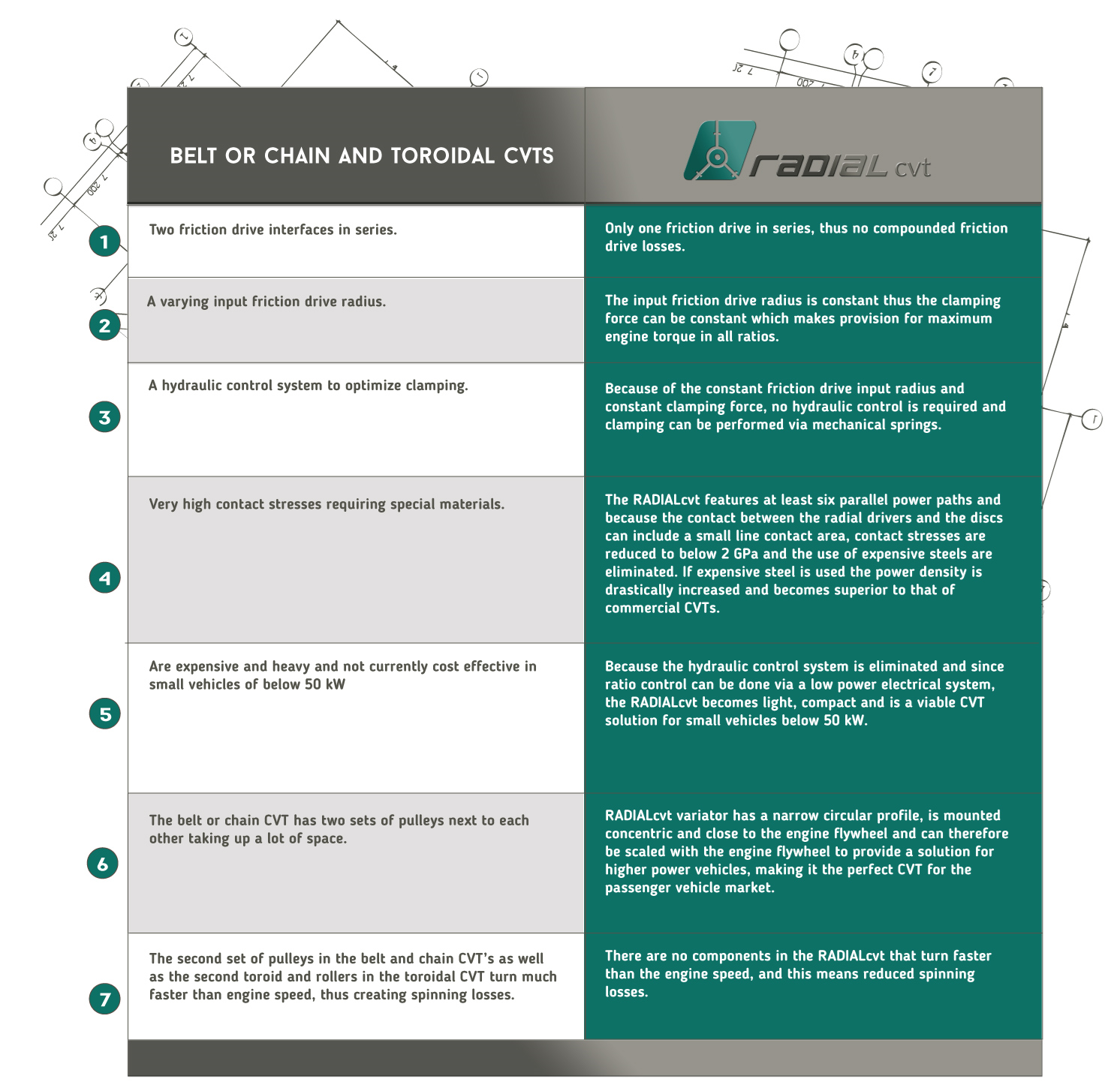
RADIALcvt-The Ultimate Commercial CVT
Varibox compares their RADIALcvt to Commercial CVTs
Transmissions play an important role in the manner with which vehicles drive, especially when taking fuel efficiency and emissions into consideration. This is why OEMs have a preference for Continuously Variable Transmissions with a proven ability to optimise engine fuel consumption and emissions.
Current commercial CVT's in the passenger vehicle market however, face criticism for being laden with inherent deficiencies like hydraulic control losses, friction drive losses, high manufacturing costs, high contact stresses requiring special materials, as well as being heavy, which results in expensive and heavy CVT solutions which are not sufficiently viable in small vehicles below 50 kW.
For this reason, Varibox CVT Technologies Pty (Ltd) developed the RADIALcvt, a multi-parallel power path type of CVT that consists of only one steel-on-steel lubricated friction drive interface in each power path.
An analysis of current development-stage and commercial CVT's in the passenger vehicle market exposes particular shortcomings associated with them. We take a look at these shortcomings in this article.
1.Belt and Chain CVT's
In the automotive passenger vehicle market there are currently only two CVT's in production; those using the Bosch Transmission push belt CVT and those using the LUK chain CVT. Individual OEM's use the manufacturers’ belt or chain and then brand the CVT transmission themselves. Both these technologies include two sets of split pulleys with a metal belt or metal chain clamped between the two pulley sets. The pulleys and belt or chain create a metal on metal friction drive interface which is lubricated in a traction fluid oil. Traction fluid oil has properties that create a friction drive film under high pressure (up to 4.5 GPa) to generate a coefficient of friction in the order of 0.1 in the metal on metal interface. The pulleys are clamped together via a hydraulic control system which uses approximately 5% of the power flowing through the CVT.
Varying input radius issues
Since the belt or chain radius on the input set of pulleys changes, the radius on the output set of pulleys must also adjust when a ratio change takes place. The clamping force varies too, as a result of the ratio adjustment. The clamping force also needs to be adjusted for different torque demands. To minimise the effect of high contact stresses and to achieve high power densities and CVT life, special materials are used, increasing manufacturing costs while a hydraulic control system is required to provide the variable clamping force.
Two friction drive interfaces in series
All belt or chain CVTs have two friction drive interfaces in series, namely from the input pulleys to the belt or chain and then, from the belt or chain to the output pulleys. This results in compound friction drive losses.
2.Toroidal CVTs
Similar to belt and chain CVTs, toroidal CVTs use a steel on steel interface in traction fluid. However, in this case, power is transmitted via a single contact point between the input toroidal and contacting roller and then from the same roller to the output toroidal, thus also featuring two friction interfaces in series. Toroidal CVTs also feature a variable input radius and are hydraulically clamped in the same way as belt or chain CVTs. In the passenger vehicle market, only the Nissan Extroid CVT transmission was in production around the year 2000.
3.Developments in CVT
Developments in belt and chain CVTs
Leading developments in belt and push chain CVT's currently involve minimizing the hydraulic control systems’ power consumption while very accurately varying the clamping force according to ratio and torque requirements. Over-clamping may occur resulting in a lower mechanical efficiency in the friction drive interface, while insufficient clamping results in excessive slipping, damaging the pulley surface. The highest coefficient of friction and the highest mechanical efficiency in the friction drive interface is created at around 2% slip. Therefore, accurate control of slip via the clamping force is very important.
Toroidal CVTs
Current developmental toroidal CVTs are all traction fluid based and in development by Ultimate Transmissions, Torotrak and NSK.
Cone ring and Planet ball CVT’s
GIF is developing a cone ring CVT, while Dana is developing a planet ball based CVT. All above developmental CVTs contain the same shortcomings as belt or chain CVTs.
The RADIALcvt Compared to Belt/Chain, Toroidal and Development-stage CVTs
Varibox developed the RADIALcvt as a disruptive technology with distinct advantages in both design and features over that of belt or chain and toroidal CVTs.
The table below shows the RADIALcvt’s competitive advantages over current commercial, toroidal and development-stage CVT’s:



